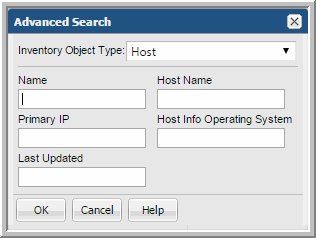Working with the Inventory List View
Leveraging data collected from your data center, the Inventory Navigator provides an accurate picture of objects discovered by StorageConsole. The StorageConsole database contains a variety of inventory object types from which data can be collected; for example arrays, hosts (and categories of hosts), switches, datastores and VM servers. Individual categories are shown and populated only when associated objects have been discovered through data collection. Each category name has a count representing the number of discovered objects within that category.
The Inventory List view displays all the collected inventory objects for a category and provides the following:
1. Toggle between the Inventory List view and the Inventory Reports.
See also:
To access the Inventory List view
1. Click Inventory.
2. Select a category.
3. Click the
Go to Inventory List icon to toggle to the list of inventory objects within the category.
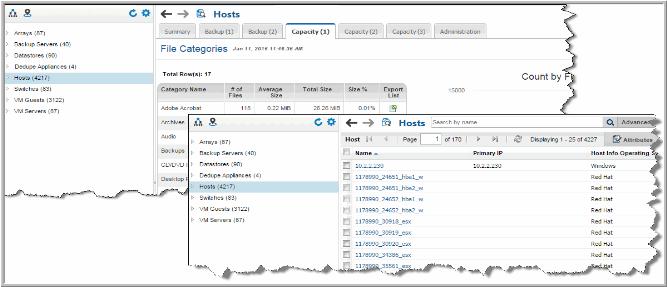
Searching the Inventory List View
Within the Inventory List view, you can search using:
Page-level search
Page-level search provides a convenient method to refine your view by locating one or many objects. This allows you to search through the selected category by
Name or
IP address and revise the view based on the search results. When filtering, you can also sort and move columns to further organize the display. See
Advanced Search for more search options.
Note: For VM Servers organized by cluster, you can also search by cluster name.
Inventory Search Rules
• Partial entries are supported
Note: Primary IP address requires the full address and does not support a partial entry.
• Case insensitive
• Use double quotes for multiple word searches
• Searching occurs on report name, object name, and descriptions
• Wildcard searches are implicitly supported: abc returns *abc*
• Use double quotes for exact search (retain word order, reserve punctuation and all stop words
such as _-., for, if, …)
• Search crawls the following fields or columns:
• Reports - Report name, short and long descriptions
• Inventory View - Object name, Primary IP address, VM Servers cluster name
• Host Management - Host name, Primary IP address
To search at the page-level
1. Click Inventory.
3. Select a category.
4. Click Go to Inventory List.
Note: For VM Servers organized by cluster, you can also search by cluster name.
6. Press Enter. The results are shown. A message is displayed to indicate the view has been filtered.
7. Review the results.
Advanced Search
The Advanced Search allows you to efficiently search through thousands of objects to access only the data you want to see. This dynamic search uses the columns displayed in the Inventory view for a particular object, as the search criteria. For example, if you select the Hosts category, and the columns shown in the Inventory view pane are:
• Name
• Host Name
• Primary IP
• Host Model
• Last Updated
Those are the same fields displayed in the Advanced Object Search dialog. The fields displayed on the Advanced Search dialog are closely tied to your column selection and dynamically change based on your object selection and column settings. As you modify the display, the Advanced Object Search dialog also changes.
Advanced Search Rules
• Partial entries are supported
Note: To search for the Primary IP address, you must enter the full address. Partial entries are not supported.
• Case insensitive
• Use double quotes for multiple word searches
• Searching occurs on report name, object name, and descriptions
• Wildcard searches are implicitly supported: abc returns *abc*
• Use double quotes for exact search (retain word order, reserve punctuation and all stop words
such as _-., for, if, …)
• Search crawls the following fields or columns:
• Reports - Report name, short and long descriptions
• Inventory View - Object name, IP address, Cluster name
• Host Management - Host name, IP address
• Relationship between fields is AND
To use Advanced Search
1. Select a category on the Inventory hierarchy panel.
2. Click the Go to Inventory List icon.
3. Select an object type, for example Hosts.
4. Click Advanced on the Inventory List view to filter the display. The fields displayed on the Advanced Search dialog are closely tied to your column selection and dynamically change based on your object selection and column settings. As you modify the display, the Advanced Object Search dialog also changes.
5. Enter the required values into the fields.
6. Click OK.
Clearing the Page-Level Search Criteria
Page-level searches enable you to create a custom view in the Inventory List view using your data center inventory as the starting point. You can quickly determine if your view has criteria applied, and clear it if required. A message and a link to clear the filter is displayed beside the page-level search.
1. Click the Clear Search link to remove all search criteria and reset the view.
Exporting Objects from the Inventory List View
You can export selected objects from the Inventory List view and download them to an Excel spreadsheet.
1. Select a category in the Inventory hierarchy panel.
2. Click the Go to Inventory List icon.
3. Select an object type, for example Hosts.
4. Select the objects to export. Click the top checkbox to select all objects on the page. Click the link to select items across all pages.

5. Click Export. The objects and the displayed columns are exported to an Excel spreadsheet and automatically downloaded.
Managing Objects in the Inventory List View
The Inventory List view enables you to manage individual objects and groups of objects. You must be in the Inventory List view to perform management operations. The following operations are available:
Note: These functions are privilege-based and not available for all object types.
Assigning Attributes in the Inventory List View
You must use the
Inventory List view to assign attributes and select their values within the
Inventory Navigator. Once attributes are created and their values defined, you can assign their values to objects represented in the
Inventory. A set of predefined
System Attributes are included in the Portal software. Once values are defined for the system attributes, you can assign them. In the
Inventory List view, you can select a single object or a group of objects and assign or modify attribute values associated with them. See also
Managing Attributes.
Limitations
• Attributes cannot be assigned to LUNs. All other objects represented in the Inventory allow attribute assignment.
To assign attributes and set values in bulk
1. Select
Inventory.
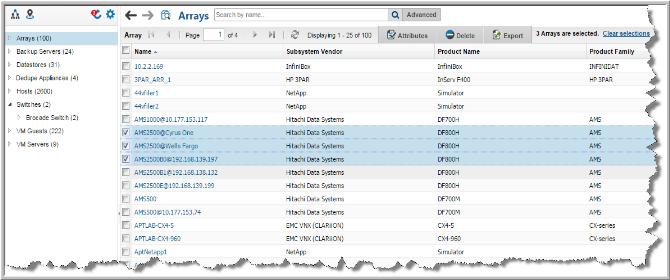
2. Navigate to the object category.
3. Toggle to the Inventory List view. You can select all the objects on the page by clicking the checkbox on the top of the management page. Note that only the objects displayed on a single page are selected.
4. Click Attributes. The Assign Attribute Values to Objects dialog shows if attributes are actively used in the Inventory hierarchy. It also allows you to set or modify an attribute (or multiple attributes) for all the inventory objects selected. If no value is set for an attribute, the field is blank. If different attributes’ values are set for the selected objects, the value displays Multiple Values.
5. Double-click the
Value field beside the attribute. A drop-down list is activated.
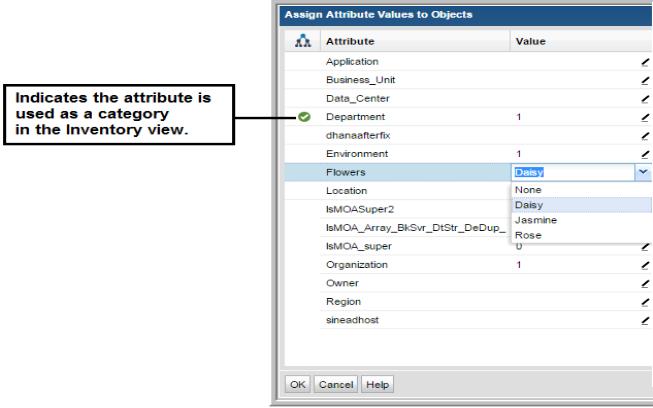
6. Choose a value to assign to the selected hosts. If the value is displayed as Multiple Values, the new value is applied to all selected hosts and will overwrite any previously set attribute. You can set multiple attributes at once.
Setting Attribute Values in the Inventory List View
You can select different attribute values or remove them entirely in the Inventory List view. You can do this on an individual object or on a set of objects. These instructions cover how to modify attributes in bulk.
To remove attribute values on objects in bulk
1. Select
Inventory.
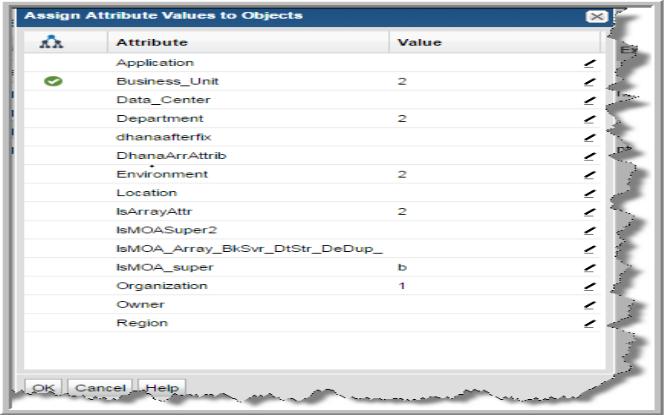
2. Toggle to the Inventory List view.
3. Enter your filter criteria to find your target set of objects.
4. Navigate to and select the objects to manage. You can select all the objects on a page by clicking the checkbox on the top of the management page. Note that only the objects displayed on a single page are selected.
5. Click Attributes. The Assign Attribute Values to Objects dialog allows you to set or modify attribute values for all the objects selected.
6. In the Assign Attribute Values to Objects dialog, double-click an attribute to set an attribute value. If different attributes’ values are set for the selected hosts, the value displays Multiple Values.
7. Click the
Value field beside the attribute you want to remove. The field is activated.

8. Select
None to remove the value. If you selected multiple objects, the attribute is removed from all your selections. You can remove multiple attributes and values at once.
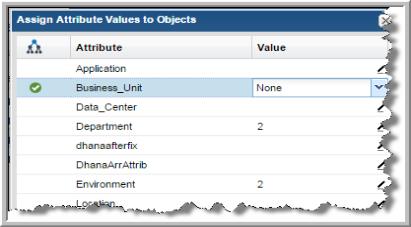
Deleting Objects from the Inventory List View
You may want to delete objects from the reporting database. If you choose to delete
an object (if you have privileges) you are irretrievably deleting the object from the reporting database. All related historical data will also be permanently deleted from the database and unavailable in all reports. A pop-up window warns you of this action to prevent inadvertent deletions. This is an audited action and requires a password before deletion can proceed. See also,
Decommission/Recommission Hosts and Backup Servers.
You can also delete hosts from the
Host Management view. See
Deleting Hosts.
To delete objects from the Inventory
Note: VM Guests, individual LUNs and datastores cannot be deleted.
1. Select Inventory.
2. Select the object type category and expand to view.
3. Toggle to the Inventory List view.
4. Select an individual object or you can multi-select.
5. Click Delete. Remember all related historical data will also be permanently deleted from the database and unavailable in all reports. Two confirmation dialogs are displayed.
6. Enter your password. This is the same password with which you logged into StorageConsole. This information is captured in the log files.
Customizing Columns in the Inventory List View
To create a custom view of your data center inventory, choose the columns to display on the page. The columns available for selection are based on your StorageConsole licenses, collected data within the your domain, and pre-built custom attributes. Once selected, sort and move these columns to your preference. Attributes can also be displayed as a column in the
Inventory List view.
See
Selecting Columns on Management Pages.

